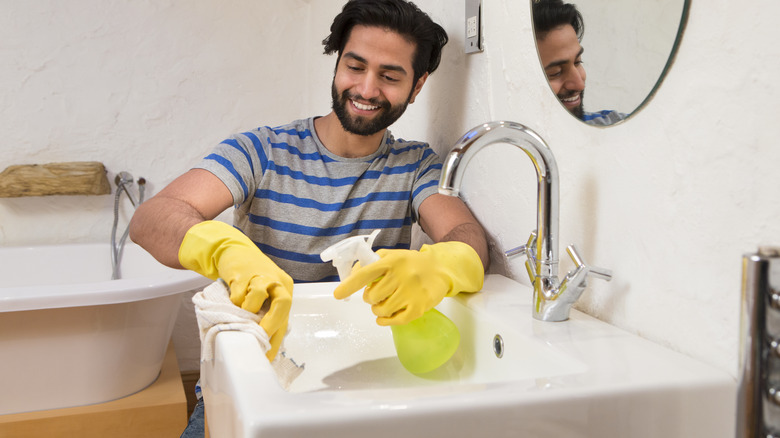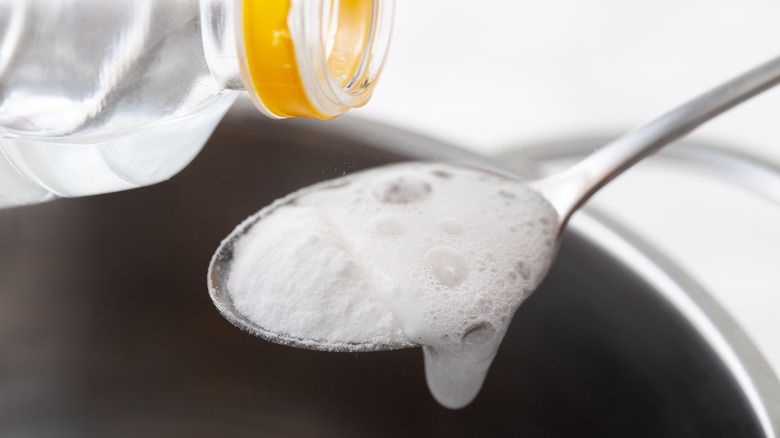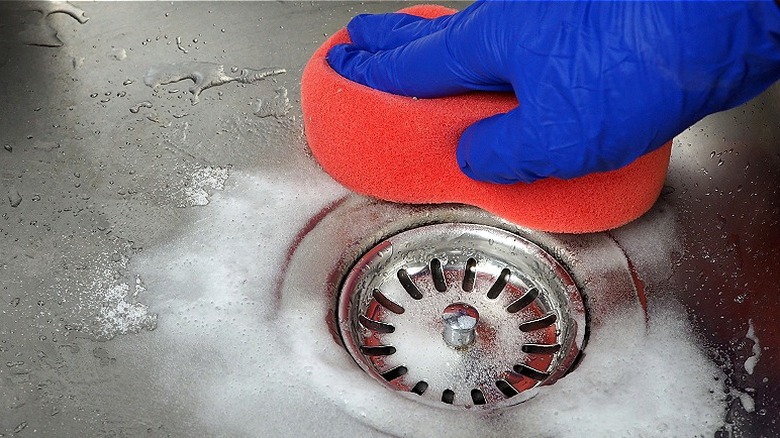What You Need To Know Before Cleaning With A Mixture Of Vinegar And Baking Soda
If you look up a DIY cleaning remedy for just about anything, you'll find two ingredients come up over and again: baking soda and white distilled vinegar. Both are affordable staples most folks already have on hand, and they certainly can pack a punch. Baking soda is a gentle but powerful abrasive, while white vinegar's high acidity can cut through all sorts of grime. Because they're both such effective cleaning tools, you've probably also come across the suggestion to combine them for particularly tough messes. While common sense might lead you to believe doing so would double the power of each, this would actually be a mistake. When combined, vinegar and baking soda are rendered pretty much useless.
Baking soda is alkaline, meaning it has a pH level above 7. Vinegar on the other hand has a pH of about 2.5. When alkaline and acidic substances are combined, a chemical reaction occurs and the solution is rendered neutral, which is neither acidic nor basic. The resulting mixture is nothing more than water and sodium acetate (salt), which as you might imagine, aren't super powerful cleaning agents.
Bubbling isn't the same as cleaning
If you've ever combined baking soda and vinegar together for a science experiment or made bread with the two ingredients, you know that the two bubble up when combined. When we see bubbles fizzing up, we often assume it's creating a cleansing foam, like dish soap or shampoo, but not all bubbles are created equally. That's because the chemical reaction causes the release of carbon dioxide gas, which makes for a bubbly display, but little else.
It's often good advice to avoid combining cleaning products because they each contain different chemicals and can have unexpected reactions, like when it comes to bleach and vinegar, which can create a highly dangerous, toxic gas, per Poison Control. When it comes to vinegar and baking soda, there's no inherent risk in mixing them together. While it does release carbon dioxide, that isn't an issue in small quantities.
But combining the two can get messy quickly if it overflows while fizzing, like when it's combined in a bottle (or model volcano), so at best, it's an inefficient cleaning mixture, and at worst, it adds to the mess you have to clean up. As a note, while vinegar is a natural cleaning agent, it's still a powerful chemical containing acetic acid, so you should only use it in a ventilated room with proper protective gear, like gloves.
What if I want to use both ingredients while cleaning?
Just because vinegar and baking soda are rendered ineffective while combined, they can make for a powerful duo when used in succession as a one-two punch. That's because alkaline cleaning solutions can attack stains, dirt, and grime differently than acidic ones. So for instance, if you're cleaning a drain and you notice that the baking soda has mostly removed the ring of grease and debris, but there's still a lingering smell coming from the drain, you may have something in there that needs to be broken down by acid. Don't just pour the vinegar into the sink, though, because as we've said, this will just make both product's cleaning power futile. Instead, once the baking soda has done what it can for the chore, rinse it away thoroughly, then add vinegar to the mix.
This also applies to laundry stains. If you run a load of washing with a cap full of white vinegar and notice a stain has lightened but not lifted completely, try running it again but with a tablespoon of baking soda this time — its alkalinity and gentle abrasive texture may be able to get the last of the stain out that the vinegar couldn't conquer.


